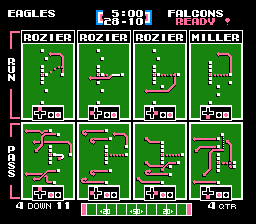 |
| 8 Bits of Over The Top NFL Fun |
Tecmo Bowl
Fifteen to twenty years ago I played one of the greatest sports video games ever; Tecmo Super Bowl. It was simple game that gave a player a limited number of plays to select and some of the star players had some outrageous and over the top abilities that added to the fun. I think it was in one of the sequels to Super Tecmo Bowl that you were able to move players around in someway. What I do remember was trying to get all of the best players on one team. But when that became boring, my brother and I decided to draft players onto opposing teams. What I came up with is in principle very similar to the two Tight End offenses you see today. To best use a two Tight End type of offense, I used a Run and Shoot Playbook.
The Run and Shoot
Back then with these old 16 and 32 bit video games, certain teams had specific and limited offenses and playbooks. The Lions, Falcons and Oilers ran the Run and Shoot. Now traditionally the Run and Shoot was run with a personnel package of 1 running back, 4 wide receivers and zero tight ends. The offense was run from under center or from the shotgun. The drawback of the Run and Shoot was that it provided the quarterback little protection and could be overloaded with a blitz or simply overpowered by a superior pass rush fairly easily. It was up to the quarterback to find the open receiver quickly making it, as Buddy Ryan famously called it; "The Chuck and Duck". The running game was under-powered with only a single running back and no fullback or tight ends for extra blocking. This caused red zone problems for Run and Shoot teams. The rushing attack was completely dependent on defenses spreading out to cover the receivers and letting the running back find his way in space. This worked fine for Barry Sanders most of the time but didn't work all the time or for all Run and Shoot teams.
Two Tight End Tecmo Offense
 |
| Falcon's Run & Shoot Plays |
 |
| Oiler's Run & Shoot Playbook |
Running The Ball
With Tight Ends or blocking Wide Receivers in at the slot positions on both sides of the formation, sweeps were the most effective run plays. However, since there was no Fullback to lead block, you had to have the best interior offensive linemen to open up holes for you at the line of scrimmage. But honestly, who really wants to run the ball when you have such a dynamic passing game?
Limitations of the Offense
But inside the red zone was another story. There were some limitations. Inside the red zone the speed of the outside receivers is not a factor and since they don't have the best hands, they didn't challenge the Corners for the ball when tightly covered. So that eliminated two receiving options from the get go. Running sort of worked but thank goodness there were no line shifts in the game.
Real World Applications & The Modern NFL Tight End
Flexibility wasn't a trait of Tecmo Bowl. You could not change plays, add motion or call a hot route. But in the real world NFL multiple Tight Ends are being used in a variety of ways. It is not uncommon for a formation shift that has Antonio Gates or Vernon Davis lined up wide and the Wide Out lined up in the slot. New England has sweep plays designed for Tight End Aaron Hernandez. Having one of the Tight Ends line up in the backfield to lead block or two of them to overload one side of the formation adds flexibility for more types of play calling and power running in the red zone. I will expand on the multiple Tight End personnel packages in another post.
No comments:
Post a Comment